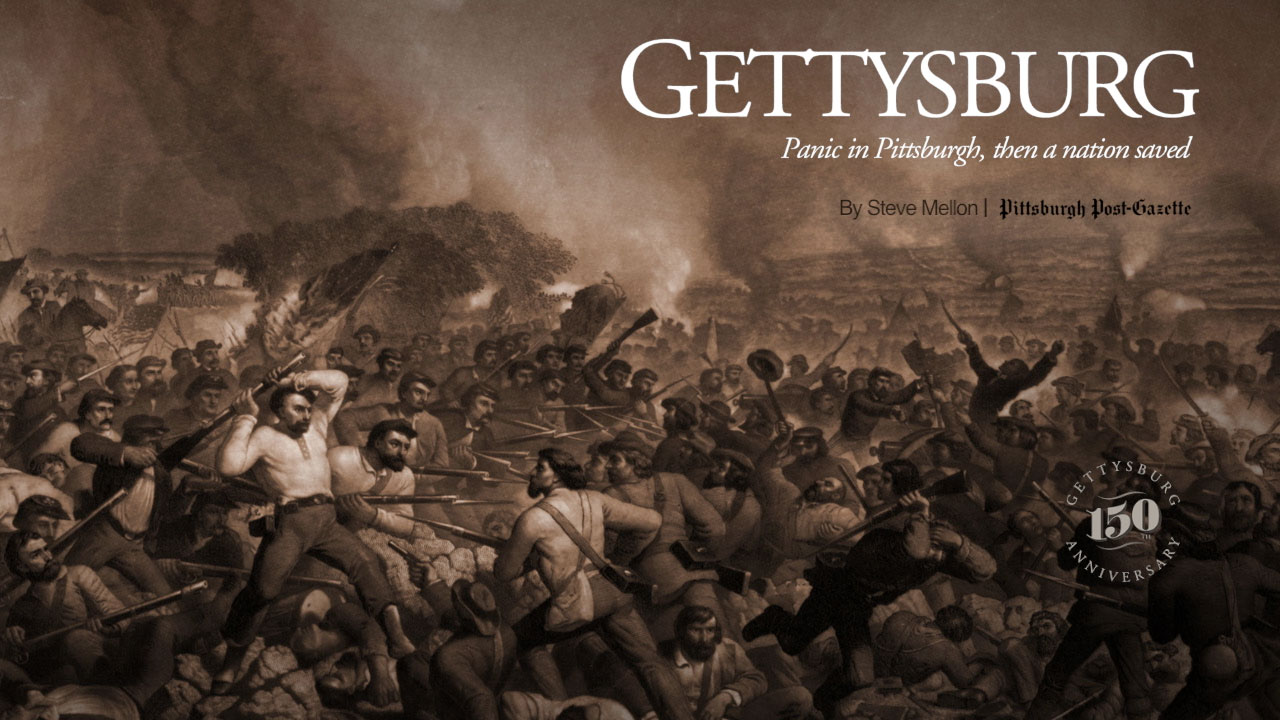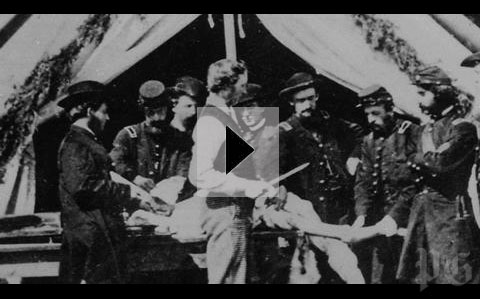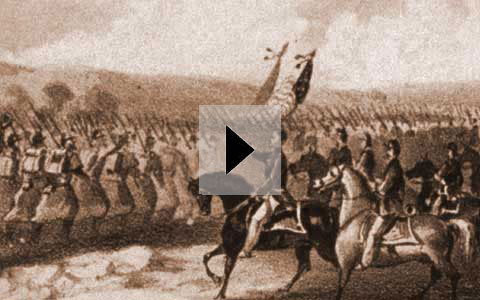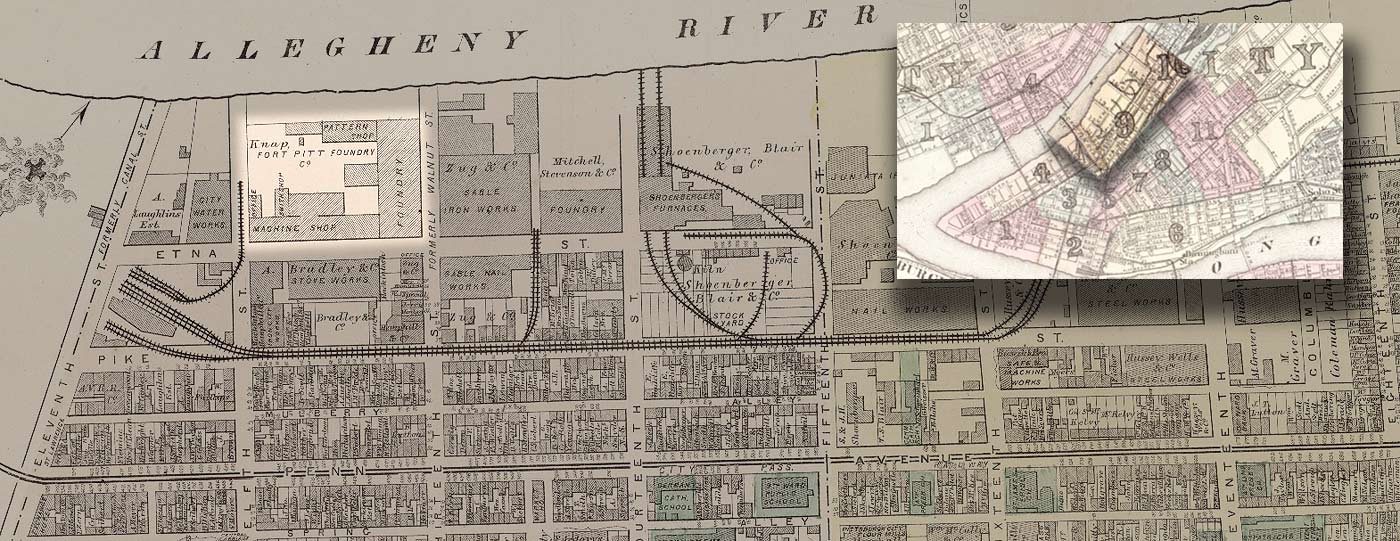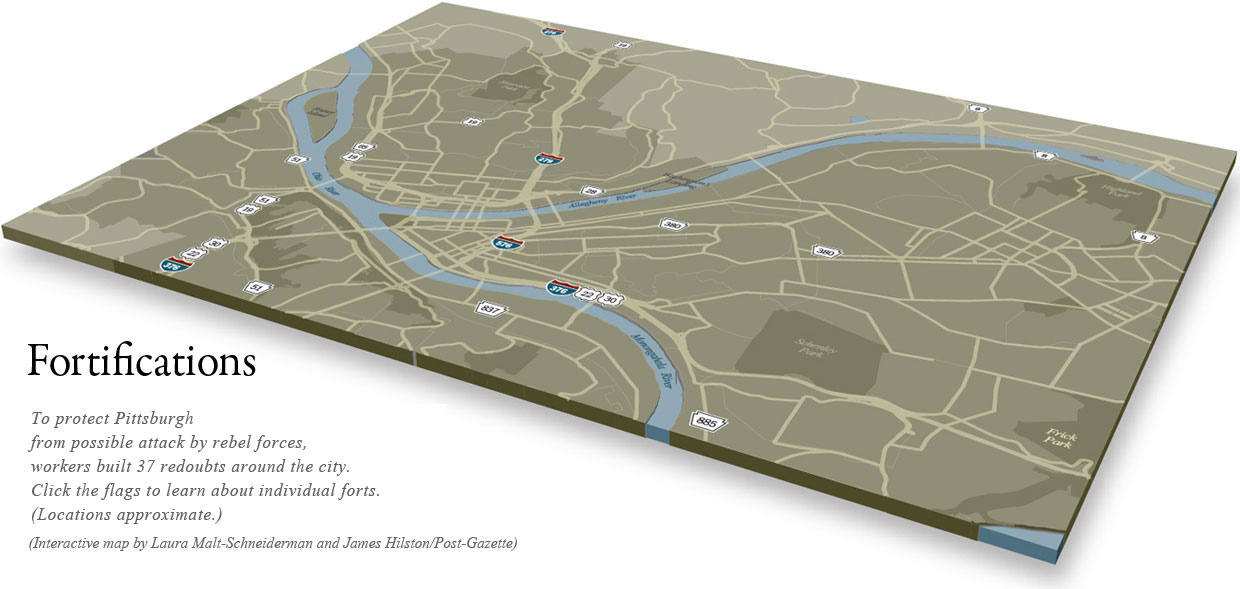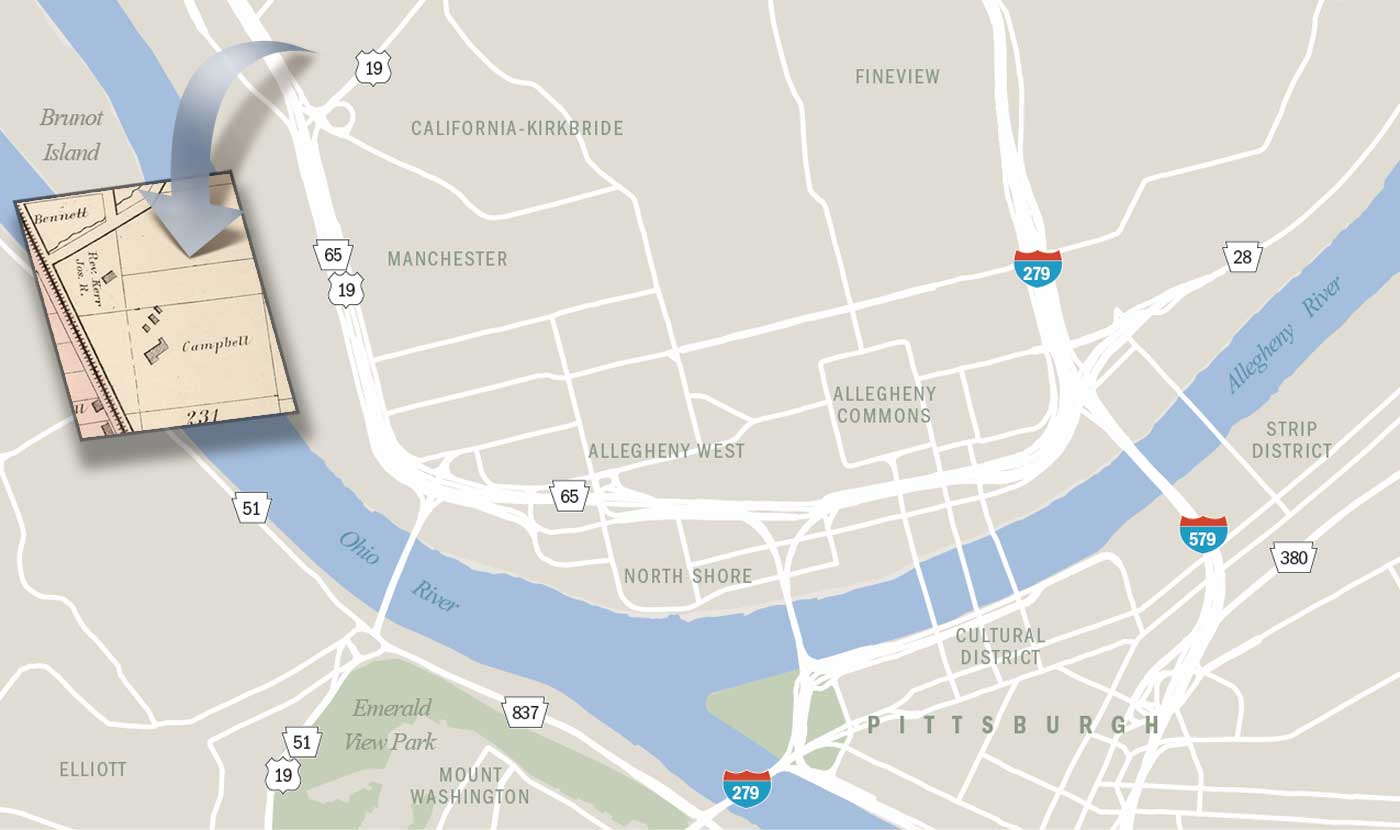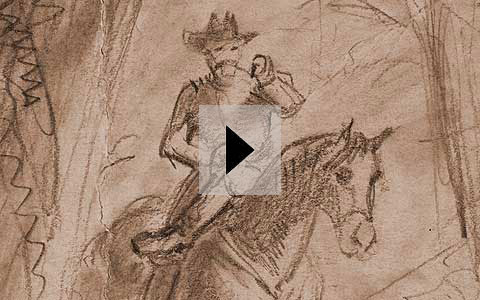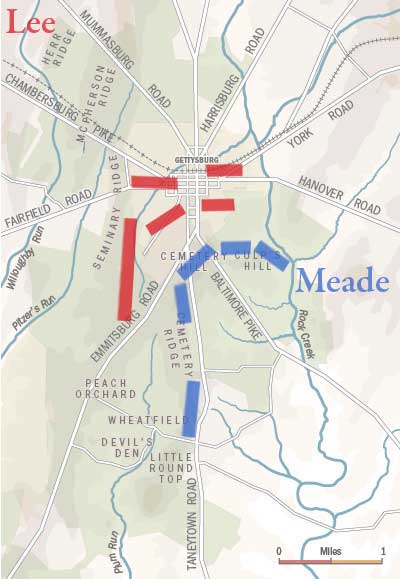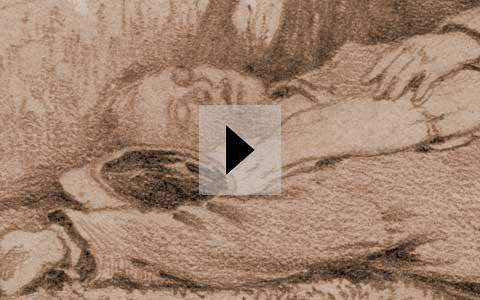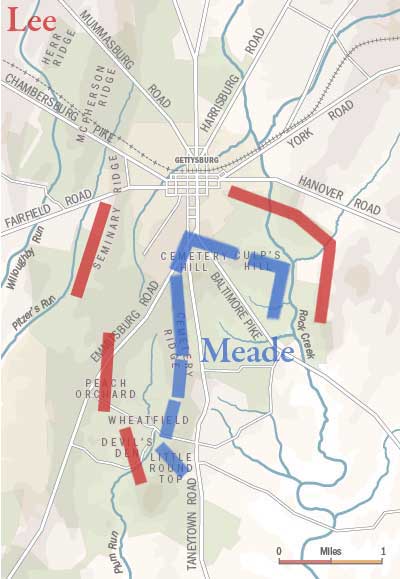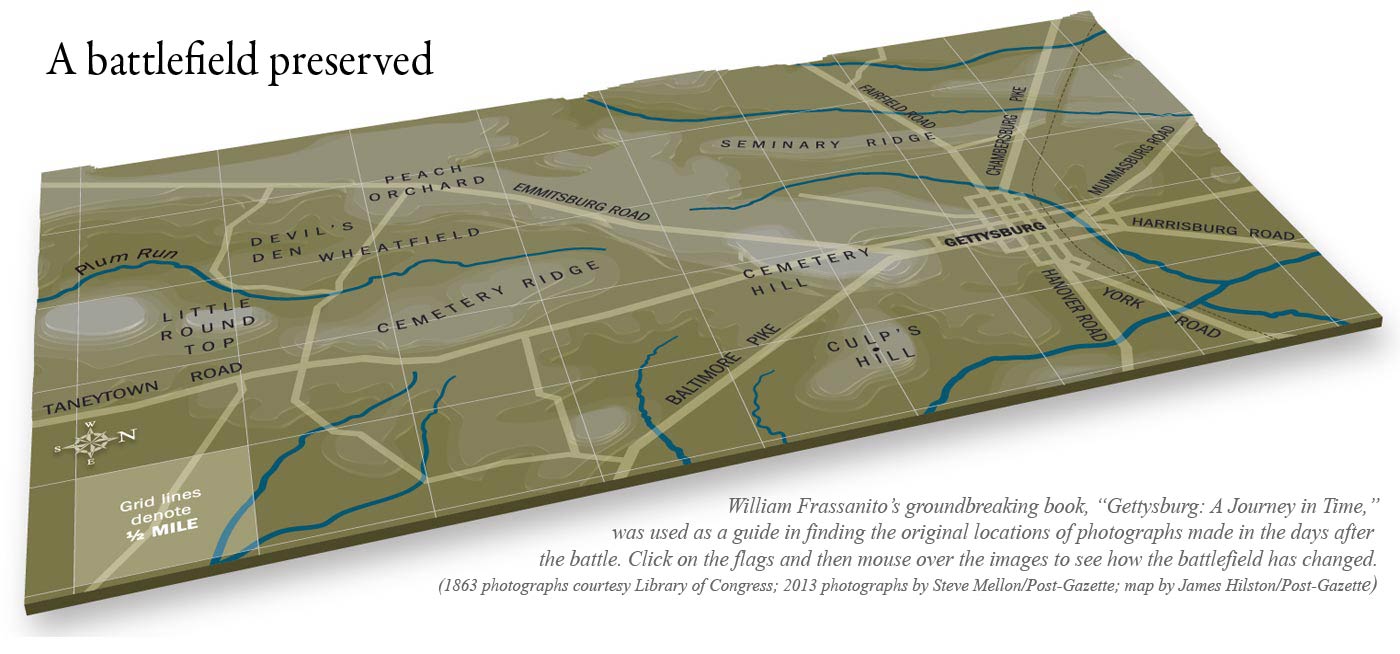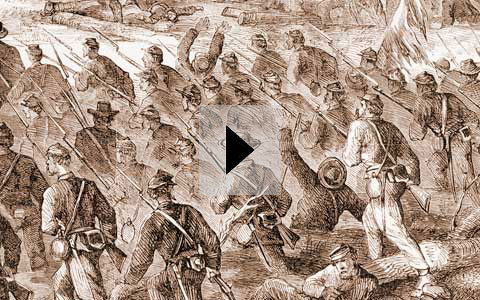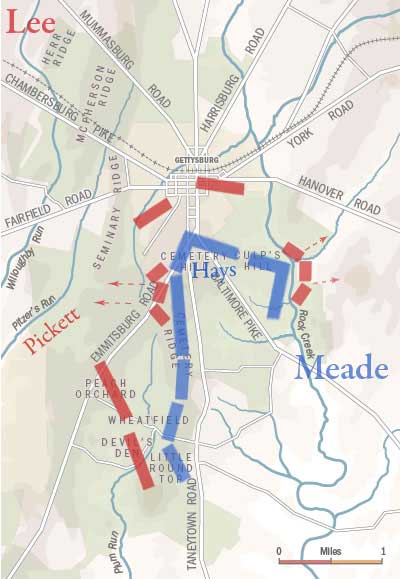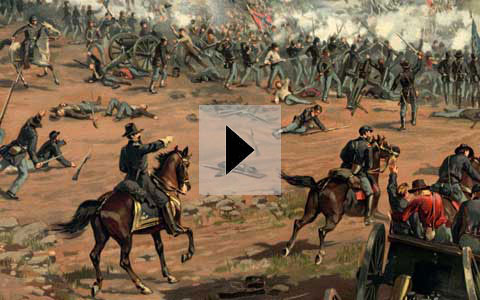Victory's price: Death, misery
You're reading this story on an outdated browser, which means we can't show you everything. Download current versions of
Firefox,
Chrome or
Internet Explorer for the full multimedia experience.
Just south of Gettysburg, a young soldier named John Nevin leads a Pennsylvania regiment across fields freshly scarred by a horrifically violent, three-day clash between two great armies. Trees are shattered and pocked with holes, crops and orchards mowed down by flying lead, fields trampled by tens of thousands of marching men, fences torn apart. A barn and a house, trapped between the two armies, have burned to the ground.
Nevin sees human slaughter on a massive scale, with an estimated 8,000 killed, many as yet unburied. The dead, Nevin writes, are "strewn around in various forms of horror," the bodies blackening in the summer heat. Rising from the battlefield is a stench that sickens Gettysburg’s residents.
Photographs made days after the battle show the bloated, contorted corpses, one disemboweled and with a hand dismembered. One of Nevin’s colleagues looks at the bodies and notes that more of them wear Union blue than Confederate gray. For the Army of the Potomac, victory had come at a great cost.
Nevin and his troops move on, to ground once occupied by the enemy. There Nevin sees evidence that the retreating rebel army had dragged many of its dead off the field and attempted to bury them. The task was incomplete. "We passed a long, irregular dark line stretching from right to left," Nevin writes. "It was the rebel dead! A disgusting sight. Poor humanity!"
By chance, John’s uncle also passes through this area. His name is Robert P. Nevin. Both Nevins are from Sewickley, a small Pennsylvania town 14 miles northwest of Pittsburgh. Robert Nevin, a writer and businessman, is appalled by what he sees in the camps of wounded, where "arms and legs amputated from the soldiers may be seen piled up in heaps as you see wood piled when it is cut for the stove."
Injured soldiers, Robert Nevin writes, lie in the hot sun while maggots crawl in their wounds.
"I went to one man, a rebel, with half his face shot away, and the wound covered with a stinking crust like a huge scab. He was moaning and groaning awfully."
Robert Nevin asks the soldier, "Poor fellow, can I do anything for you?"
The soldier murmurs so indistinctly that Nevin must bring his ear close to hear the response: "Water, water."
Nevin quickly finds a member of a relief organization called the Christian Commission, who brings a pail of water. The injured soldier drinks, "Oh, with what apparent rapture," Nevin writes.
As he writes about these torn, suffering soldiers, Robert Nevin thinks of his nephew: "If John Nevin should happen to get wounded, I would like to be about to see him properly waited upon."
Robert Nevin’s account comes from a letter to his wife, Elizabeth, at an address on Wood Street in Pittsburgh, 190 miles northwest of the appalling scenes in Gettysburg. In contrast, Pittsburgh is in a celebratory mood. Revelers pack Pittsburgh’s streets, giddy men discharging pistols into the air and mischievous boys setting off fireworks under the feet of horses. It’s a sudden and shocking change in the city’s attitude. Just a few weeks earlier, Pittsburgh had been in a near panic. Store owners locked the doors of their shops and ordered employees to assist in the building of fortifications to protect the city. Newspapers plastered their pages with alarming headlines. Rich folks buried their fine silver in gardens and fields. Pittsburgh was preparing for the worst.
One battle with more than 51,000 wounded, missing, captured or dead — many of whom are now awaiting burial in those fields and woods surrounding Gettysburg — has changed everything.

Mouse over the image.
i
Pittsburgh has changed remarkably in the nearly 150 years since Otto Kreps published this 1871 lithograph showing Pittsburgh, Allegheny and Birmingham. Mouse over the image to see Pittsburgh in 2013. (Otto Kreps image courtesy Library of Congress; contemporary photograph by Steve Mellon/Post-Gazette)
Still, folks in Pittsburgh were certainly aware the country was at war with itself. Evidence in the form of thick, black smoke poured from the city’s iron works and foundries, where workers were busy producing cannons for the Union army. War was big business and Pittsburgh prospered. Industries here produced nearly anything the Union army needed: gun carriages, wagons, blankets, harnesses, saddles, horse collars, gun holsters, military drums, clothing, artillery rounds, even ironclad ships. Girls wearing hoop skirts flocked to the Allegheny Arsenal in Lawrenceville to assemble ammunition.
Downtown, Union soldiers crowded the city’s streets. They came by steamboat and by train and by foot. Sometimes they marched and paraded. Other times they staggered from taverns or escorted young ladies to theaters. They packed themselves into the city’s hotels. For about 5 cents, a soldier could eat at a warehouse-turned-dining hall at the intersection of Ninth Street and Penn Avenue. Some stopped by a Third Street brothel operated by "Mrs. Black," who employed eight ladies for the business of keeping the young men happy. The Soldiers Home on Liberty Avenue provided care and comfort for the sick and wounded.
Even the enemy passed through town. Rebel prisoners on a train to Fort Delaware were seen here in early June 1863. "They were a very dirty looking set," reported the Pittsburgh Post. "But that was nothing more than was to be expected from men cribbed, cabined and confined in box cars and bound for a long journey." One of the soldiers, a man named Collins from the 40th Alabama regiment, had died on the train. His body was removed here so the coroner could perform an autopsy.
Pittsburgh during the Civil War is smaller, smellier and dirtier than the shining metropolis it will become a century and a half later. In 1861, the combined populations of Pittsburgh and Allegheny City, now the North Side, is 78,000.
Illustrations from that era show the Golden Triangle as a mash of mostly two- and three-story brick and wood-frame buildings. Here and there, church spires rise above the squat skyline. The massive and elegant Monongahela House — at the time, one of the country’s finest hotels — dominates the south end of Smithfield Street, next to a suspension bridge crossing the Monongahela River. Steamboats line up bow first along the Mon Wharf.
The acrid smoke from all those iron works, foundries, mills, tanneries and machine shops, together with the stench of horse manure, forms a pungent mix. Industry discharges waste directly into the rivers and the Allegheny Wharf is often trashed with scraps from tin shops, saddleries and other factories, as well as "slop" from houses and the produce from what one newspaper calls "night soilers."
Across the Allegheny River to the north, in a somewhat more pastoral setting, sprawls Allegheny City. Trees are absent in those old illustrations of Pittsburgh, but they appear plentiful in Allegheny City. Houses, businesses and industry are clumped near the river, but hills to the immediate north and west are lush and green.

Margaret Wade Campbell
Maggie Wade Campbell's life got off to a rough start. She lost her mother upon childbirth in 1857. Two weeks later, her father died. Maggie was raised by her mother's sister, Lois Wade, and Lois' husband Benjamin Bakewell Campbell, who lived in Manchester, now a part of Pittsburgh's North Side. By age 12, Maggie had developed a love for writing. She married Lorin Deland in 1880 and moved to Boston, where she established a career as a novelist, short story writer and poet. (Photo from "If This Be I, as I Suppose It Be")
A girl named Maggie Wade Campbell lives here, among the woods, fields and orchards surrounding her family’s estate, located near what’s now the Marshall Avenue exit off State Road 65. The war has inspired Maggie and her friends to concoct games like "hanging Jeff Davis from the sour apple tree." Once, Maggie used the bloody hatchet by her family’s hen house to pretend to cut off the head of the Confederacy’s president.
Years later Maggie would be known as novelist Margaret Deland and, in a memoir of life on Pittsburgh’s North Side during the war years, she recalled the delight she felt as the hatchet came down on the chopping block with a solid "whack."
She remembered the thrill she felt as she stood on a sloping hillside on a warm summer day, digging her heels into the grass so she wouldn’t slip, and watched the trains as they passed through the cutting below her, the locomotive laboriously puff-puff-puffing as it pulled a sad, bloody cargo of wounded soldiers, the locomotive’s black smoke rising and then settling over Maggie and her clean dress. Maggie was perhaps 5 years old — we don’t know exactly. In her memoir, Margaret acknowledges certain details like exact dates are unclear.
Other details, though, remain sharp: the series of cattle cars, for example, with soldiers sitting on the roofs, their legs dangling, some leaning against one another, many with bandaged heads or arms in slings. Some will call out to Maggie or salute her and maybe even sing a song as they pass. Sometimes Maggie tosses flowers or fruit to the passing troops. Always she waves a handkerchief.
Once Maggie saw a soldier up close. It happened when she and her aunt rode one of the city’s streetcars to Lawrenceville to visit relatives. Maggie remembers the musty smell of straw on the floor of the streetcar, the tinkling of the bell on the collar of the single mule as the car bumped along Penn Avenue, past the Allegheny Arsenal. Across from Maggie sat the soldier, a boy, really, his drum on the floor between his muddy boots. Maggie admired the soldier’s blue coat, his brass buttons. She figured they’d be great for the games she and her friends played. How could she get them? Her young brain devised a plan. She leaned forward and asked in a loud, eager voice, "Will you marry me?"
Soon, however, Maggie will know war as something other than a setting for childhood games. In June 1863, the conflict tearing apart the country and resulting in so much death and bloodshed will become a dark, ominous presence for her and all of Pittsburgh. A single, seemingly innocent incident will shock Maggie into understanding the threat.
Flowers and edgy nerves
In the heart of enemy country in Centreville, Va., a woman named Annie Hays sits in a Union army camp and writes a letter to her daughter Agnes. It's a Saturday, June 13. Annie has traveled from her Western Pennsylvania home to Virginia so she can visit her husband, Brig. Gen. Alexander Hays. The Hays family, according to the 1860 census, lives in Collins Township, an area that later will be annexed by Pittsburgh and include the Morningside and Lawrenceville neighborhoods.
Hays is the epitome of a Civil War general — pictures show him as big and burly, with a full, wavy beard. His bearing is stern and erect, but his eyes, shaded by droopy brows, reflect a certain kindness.
In a few weeks, Hays will risk his life at Gettysburg in ways at once considered reckless, courageous and memorable. But on this day, Annie calmly writes that she and her husband spent the day in a manner that belies the fact that they are in the midst of a bloody and costly war.
"... Papa and I mounted our horses and visited two regiments and afterwards went some miles to a deserted house and collected a quantity of roses. I have sent Gen. Abercrombie a pretty bouquet and as soon as I write this I will take some down to the hospital."
The war has delivered Hays from a civilian life most notable for business ventures gone bad. After studying at Allegheny College and then West Point, he served heroically in the Mexican-American War. After resigning his commission in 1848, Hays returned to Pennsylvania, failed in the iron business, then traveled west to search for gold. He failed at that, too, then settled in the Pittsburgh area and worked as a civil engineer. News of the attack on Fort Sumter in the early months of 1861 roused his patriotic spirit. Now, he once again wears a military uniform and has seen heavy action in a number of battles, including Yorktown, Seven Pines and Malvern Hill. In the Seven Days battles he led a bayonet charge, and at Second Bull Run a rebel bullet shattered his leg.
He and Annie are raising six children at their Collins Township area home.
Annie writes to Agnes, "Papa sends love."
Approximately 50 miles south, the Sewickley soldier John Nevin and others of the 93rd Regiment of the Pennsylvania Volunteers stand in the dark near Fredericksburg, Va., and get drenched in a rainstorm.
And they wait.
The time is 11 p.m. Soon, the Pennsylvania troops will attempt something they fear is quite dangerous -- crossing the Rappahannock River. They're understandably a bit jittery after having spent the previous day on a forward picket line, hugging the ground and listening to Confederate sharpshooters' bullets whiz past. It was nerve-racking duty, being within rifle range of the enemy, lying flat all day, unable to raise your head without drawing a bullet. "Old soldiers say they would rather go thro' a pitched battle than such a day again of June 12," Nevin writes.

John Nevin
John I. Nevin was born in Allegheny City, now Pittsburgh's North Side, in 1837. A graduate of Jefferson College, he taught history at Sewickley Academy before enlisting in the Union army in 1861. He was captured near Harper's Ferry in 1862 and spent six months in Confederate prisons before his release as part of a prisoner exchange. After Gettysburg, he fought in the Battle of Cedar Creek and at the Battle of the Wilderness. (Photo courtesy Detre Library and Archives, Senator John Heinz History Center)
Nevin has spent two years in the Union army, and in that time he's risen to the rank of major. His journey to this now soggy portion of Virginia began in Sewickley on a warm day in 1861. Townsfolk had gathered in the local Presbyterian church, listened to speeches and bid farewell to Nevin and other members of the newly formed "Sewickley Rifles." Each soldier was presented with a New Testament; Nevin, as Second Lieutenant, was handed a sword. Then the boys hopped on a train and joined the war effort. Since then, Nevin has been involved in a number of skirmishes, been captured, spent six months in Confederate prisoner of war camps, released in an exchange, and fought at Chancellorsville.
He and his fellow soldiers are now combat veterans, part of Maj. Gen. John Sedgwick's 6th Corps. They've been positioned in Fredericksburg to keep an eye on the rebel army stationed there. But now the 6th Corps has been ordered to move north, and this involves crossing the Rappahannock River. Rebels control the heights overlooking that river. Nevin looks up at those heights and figures the Confederate guns he's certain are positioned there can make a bloody mess of his regiment when they're exposed on the river bank.
Finally, Nevin and his fellow soldiers standing in the rain hear a command to move forward, and they proceed to a pontoon bridge. Surely, Nevin thinks, the enemy has been alerted by the clammer — federal artillery noisily rumbling away and the loud cursing of the frustrated drivers.
The crossing begins. Nevin's nerves are on edge. "... It was one anxious moment," he later writes, "for we expected every moment that the great guns that half encircled us would open on us with their concentric fire."
To his surprise, the crossing is uneventful. The rebel army is withdrawing.
"Something else is in the wind," Nevin writes. "Rumor says that Lee is moving northward."
He's referring to Robert E. Lee, commanding general of the Confederate Army of Northern Virginia. When he was first appointed to the position, Lee's men considered the regal, gray-haired general somewhat hesitant in his leadership. "Granny Lee," they called him. But he's since proven himself a superb military tactician. He'd intimidated, outmaneuvered and humiliated his counterparts in the Union army, winning a number of battles against larger Union forces, and both stunning and demoralizing those in the north.
Lee is indeed on the move and, as Nevin speculates, is taking his army north in the hopes that the Army of the Potomac will follow. The audacious invasion will allow Lee’s gray-coated force to get needed supplies from the rich Pennsylvania countryside and relieve war-weary Virginia. And, should the Confederates once again defeat the seemingly hapless Union army — this time on the federal’s own soil — perhaps Lee can draw the war to an end. Such a rebel victory could cause political division in the North and force the federal to sue for peace.
Confederate forces sweep aside Union troops at the Virginia towns of Winchester and Martinsburg, clearing a path for the rebels to move en masse through the Shenandoah Valley. To those in the north who have followed newspaper accounts of the war, Lee’s army is a fearsome and nearly invincible foe. Now the Confederates are marching toward Pennsylvania.
News of Lee’s movement speeds northward, setting off panic along the border. Leaders in Baltimore and Harrisburg build fortifications and brace for an attack. Adding to the tension is the mystery about Lee’s whereabouts. His forces are now shielded by the Blue Ridge Mountains, and Union military leaders can’t get a fix on where the different elements of the Confederate army are located. Lee is crafty, quick and unpredictable. No one knows what he’s up to. Many Northerners worry about Lee’s brilliant cavalry commander, Gen. J.E.B. Stuart. Stuart and his troops have the ability to move quickly over a wide area and cause a lot of problems.
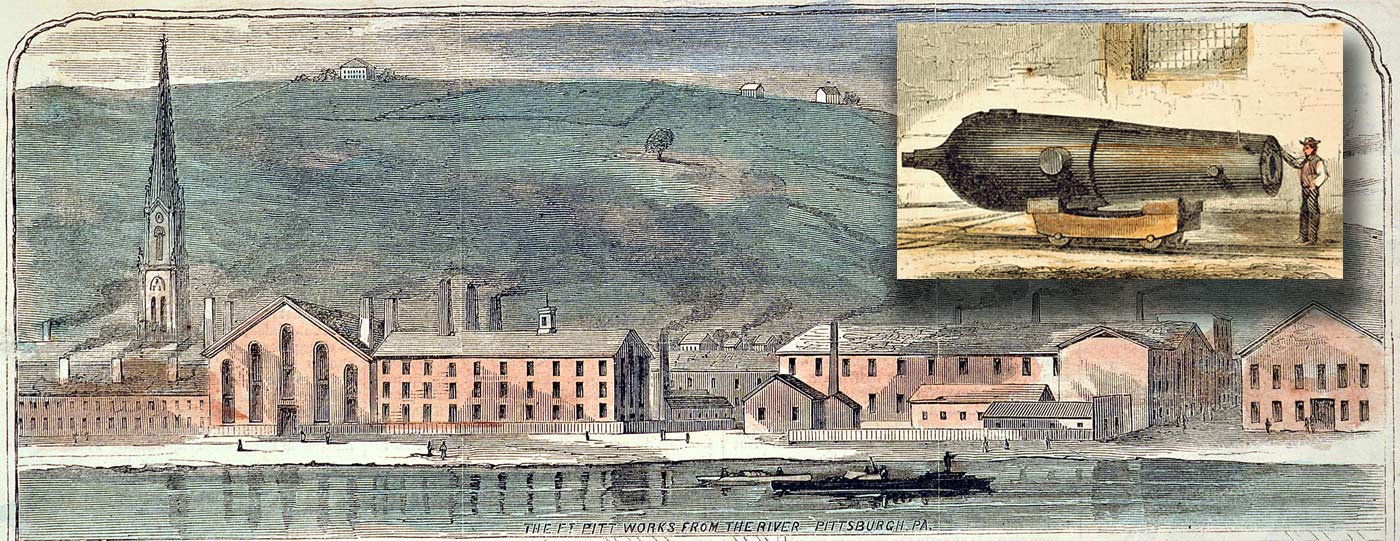
Mouse over the image.
i
The Fort Pitt Foundry, located in Pittsburgh’s Strip District, produced more than 2,000 pieces of artillery — by some estimates, up to 80 percent of the army’s heavy cannons and 15 percent of its field artillery. The largest gun produced was the Rodman Gun, a 20-inch bore cannon (see inset picture), which could shoot a 1,080-pound projectile five miles. These renderings of the works were published in Harper’s Weekly in 1862. (Fort Pitt Foundry images courtesy Detre Library and Archives, Senator John Heinz History Center; 1872 map from G.M. Hopkins, "Map of the Cities of Pittsburgh and Allegheny, and the Adjoining Boroughs," courtesy the Historic Pittsburgh website)
Many in Pittsburgh feel as if their hometown has a big, fat target painted across its midsection.
The Pittsburgh Post sounds the alarm on June 13 — the same day Annie Hays writes her letter home and John Nevin crosses the Rappahannock: "If Pittsburgh is captured, its arsenals, its mills, foundries, factories, shipyards, depots, storefronts and all would at once be demolished," the Post predicts. "It is of vital importance not only to its citizens but to the country at large that Pittsburgh shall never fall into rebel possession."
It’s a challenge the city’s civic and industrial leaders take seriously. The following day, they gather at the Monongahela House on Smithfield Street and decide that all business in Pittsburgh must come to a halt. A great emergency is upon the city, they declare. Able-bodied men are told to gather at 8 o’clock the next morning in front of the hotel "for the purpose of placing the city and neighborhood in proper state of defense," the Post reports. "… An invasion of the enemy is now hourly imminent."
By proper defenses, the leaders mean earthen fortifications — a number of them, located on high ground, surrounding and protecting the city. If Confederate troops come this way, the men of Pittsburgh intend to give them a fight.
To do this, of course, the city needs sober men. So mayor I.B.C. Sawyer directs all saloons, bars and restaurants closed until otherwise ordered. Pittsburgh will attempt to be a liquor-free zone.
As the sun rises the next morning, streets outside the Monongahela House are jammed with men carrying axes, picks and shovels and ready to do their duty to save the city and Union. Gen. William T.H. Brooks, who is in charge of defense preparations in Pittsburgh, had asked for 2,000 men, but newspapers report a much larger turnout. The men are divided into three groups and instructed to build fortifications on Herron’s Hill, Mount Washington and Washington Pike.
Once the men march off to work, thousands of people fill the Downtown streets. With all shops closed, there’s little to do but exchange news and rumors. One shocking rumor reports that rebel forces are within 8 miles of the city.
In the midst of all this commotion, Brooks moves his headquarters to a large house at 163 Second Street.
As it moves north through the lush countryside of Maryland and Pennsylvania, Lee’s army is living off the land, which means it must continue to march, or else it will exhaust the supplies around it. Confederate forces sweep up food, clothing, cattle, pigs, shoes, milk, eggs, hay and anything else they can use.
The rebel army is also gathering up all African-Americans in its path and sending them south as slaves. News of this Southern strategy sends waves of fear through black communities in southwestern Pennsylvania.
The Army of the Potomac, led by Joseph Hooker, a general with a reputation as a hard-drinking ladies man, races north on a course of its own, in hot pursuit of the rebel army. Hooker is uncertain of the exact location of Lee’s forces or where they’re headed, but he is certain of one thing: his orders. President Abraham Lincoln has directed Hooker to go after the rebel army and protect the nation’s capital. Hooker must position his army between Lee’s forces and Washington, D.C.
Among the federal forces pursuing the rebels are Nevin and the Pennsylvania volunteers. After crossing the Rappahannock, Nevin and his men endure a grueling three-day march with little rest. "For the last few hours, the road has been lined with men worn out and sick, owing to the intense heat, the suffocating dust and the rapid marching … ," Nevin writes. "What is the use of this forced marching just now?"
The next day, the volunteers reach Fairfax Station, Va. Nevin estimates he and his men have marched 43 miles since crossing the Rappahannock. It is on this leg of the march that the Pennsylvania troops hear reports that the rebels have been spotted in Pennsylvania. Lee has indeed invaded their home state. "The news animated and pleased the boys," Nevin writes. Morale, which had plummeted with defeats in the South, rises as the troops move north. Now, they’re ready for a fight.
In Pittsburgh, the summer heat intensifies. So does work on the city’s defenses. Thousands of men dig earthen redoubts around the city, from Manchester on the North Side to Highland Park, Squirrel Hill and Greenfield to the east. In all, 37 fortifications will be built.
i
In a massive effort to protect Pittsburgh from possible invasion by Confederate forces, workers dug 37 earthen redoubts that ringed the city. Mouse over the icons to learn about individual forts. Fort locations are approximate. (Interactive map by Laura Malt Schneiderman and James Hilston/Post-Gazette)
Digging the earthworks is exhausting work, especially in the summer heat. Supplies of water and other provisions are provided to the workers, who are urged not to stray from the fortifications. Parents are told to "restrain their children from visiting the works."
African-Americans in Pittsburgh and Allegheny City step up to do their part. Free blacks build Fort Robert Smalls, a circular redoubt at the mouth of Becks Run in Arlington Heights. Working on the fort are 97 black men and 27 white men. The blacks, reports the Pittsburgh Gazette, "labored with great energy."
About this time, an African-American named Butler is arrested in Pittsburgh and charged with breaking a law forbidding the enlistment of Pennsylvania men in regiments outside the state. Butler sought volunteers for the 54th Massachusetts, one of the first African-American units organized during the Civil War. Within a month, the 54th will be wrecked while making a heroic and historic attack on Fort Wagner in South Carolina.
On Thursday, June 18, the Post reports a force of the enemy has advanced 12 miles west of Cumberland, Md. "… The rebels are advancing in force and are only about ninety miles distant from this city," according to the newspaper. This is "unmistakable indication of their purpose to invade the neighborhood." Men of Western Pennsylvania are called upon to immediately sign up for military duty.
Those who need further motivation should employ their imaginations, the Post says. "If ever there was a time for the citizens of Western Pennsylvania to awaken in earnest, before the horrors of civil war are actually thrust upon their homes and firesides, now is that time. Throw off all apathy — bring your ruined households and murdered families before your minds."
Squads of men from all parts of the county march through the city’s streets to the music of fife and drum, the Post reports. The "appearance of things in the street was truly warlike."
The patriotism isn’t universal. A "foul-mouthed" Englishman stands on St. Clair Street (now Sixth Street), praises Jefferson Davis, the Confederate president, and declares he can "whip any American on the street," the Post reports. Of course, someone takes him up on that challenge but before things get too nasty, a city alderman named Donaldson steps in to separate the two belligerents.
That altercation may be related to a bit of news reported by the Pittsburgh Evening Chronicle on June 20. After a two-day closure, the newspaper says, liquor sellers have grown impatient and reopened their doors, "to the great relief of numerous thirsty souls."
i
Gen. Alexander Hays, center foreground, and members of his staff in an undated picture. (Detre Library and Archives, Senator John Heinz History Center)
The dust is causing problems for her husband. Gen. Hays has been "suffering severely with his eye for the last 24 hours," Annie writes. "He has both bandaged up now. The doctor thinks it is the dust, as the air is so full of it we can scarcely breathe."
She adds, "I feel very anxious about this raid into Pennsylvania and wish I was at home."
John Nevin, too, has felt the weight of the heavy, oppressive summer air. While on the march to the tiny town of Fairfax Court House, he had watched exhausted soldiers stagger and reel and then fall out of the ranks, overcome by the heat. Relief comes in the form of rest and a cool rain the next day, June 19. Nevin and his men receive mail, but get little to eat. They can hear cannon fire in the distance. Union cavalry breaks camp and moves out. "We are put in readiness for instant movement … ," Nevin writes.
The next day, more sounds of fighting echo in the federal camp. "Curious!" Nevin writes. "Heavy cannonading as yesterday. They tell us it is cavalry and horse artillery fighting [in] Aldie 20 miles distant. We hear it very distinctly."
What the Pennsylvania volunteers hear is a clash between Union cavalry and Stuart’s Confederate troops, who are blocking gaps in the Blue Ridge Mountains to keep federal eyes off Lee’s army.
The sounds of battle continue two more days. Still, Nevin and his fellow soldiers sit in camp and wait. Nevin wonders what’s going on. "Pleasant rumors" about a Union victory filter into camp, "but we’ll have to wait for the Washington papers to find out the truth." he writes. " … It is a positive fact that we never know or understand (we poor subordinates) what the army is doing at any given time, even if we ourselves are engaged in the affair, until we get the Northern papers."
In Pittsburgh, a housekeeper hands an unloaded shotgun to Andrew Mellon and posts him on duty at an orchard fence on the family’s property. Andrew is 8 years old and the son of Thomas Mellon, a judge who will later become a banker. In decades to come, "Mellon" will become one of the city’s, and country’s, most prominent names. What concerns the Mellon family on this day is not the Confederates, but the laborers working on nearby fortifications. Andrew’s job is to protect the Mellon cherry trees against theft by hungry workers looking for a free snack.
Freelance foraging is a problem in other parts of the city, too.
On Herron Hill, some workers drift from the fortifications to steal hams and dried beef from nearby stores. Homes are burglarized and women are harassed. Finally, a detachment of 10 soldiers is dispatched to the area to keep the workers in check.
Downtown, a note is posted on the doors of many business and stores: "All hands are employed on the fortifications," it reads. Even the city’s newspapers pitch in. On Tuesday morning, June 23, the Post reports, "We shall have the indulgence of our readers for the lack of reading matter this week as most of our employees are working on the city fortifications."
The need to sacrifice business (and profit) for the defense of the city is not felt everywhere, though. A few merchants remain open, much to the displeasure of the newspapers and the city’s most patriotic, flag-waving citizens. An appeal is made to "ladies and others not to patronize the parties who have manifested so much selfishness and illiberality during our present crisis." These stores, the Post sternly reports, will be visited by a "committee" and a martial band. Names of the offenders will be published in the city’s newspapers.
Most of the offending store owners take the hint and close their doors. There is one notable exception: A businessman known as "M. Amburgh," who may have been the Moses Amberg listed in an 1863 city directory and identified as a clothing merchant at 300 Liberty.
The "committee" pays the store a visit, but it serves only to agitate Amburgh. He refuses to close his business and indignantly orders the gathered throng to get lost. When the crowd refuses, Amburgh orders his salesman, identified as Mr. Soloman, to rush to the mayor’s office and ask for a squad of police. Soloman refuses the order of his boss and is immediately fired. Only then does the frustrated, or perhaps wily, Amburgh close his doors.
According to a report in the Pittsburgh Gazette, he reopens once the crowd disperses.
Tension and fear are on the rise. Maggie Wade Campbell — who had had so much fun with the war, playing games and waving at passing soldiers — is becoming concerned. She has become vaguely aware of a dark and sinister presence that’s connected with the war. When she walks into a room, chattering adults shush each other. No sense in alarming the children. Of course, the shushing and awkward silence chills Maggie.
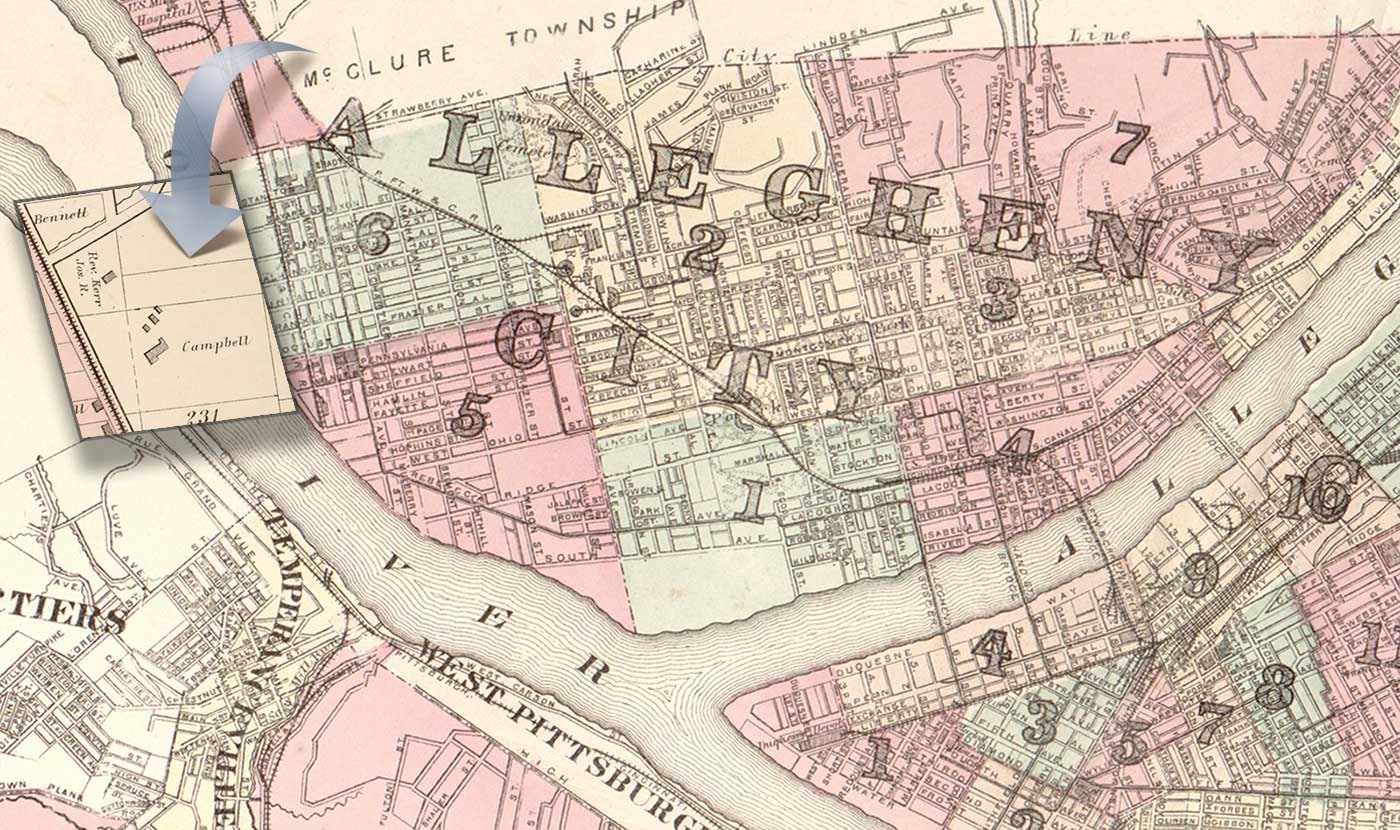
Mouse over the image.
i
The 1870 federal census shows the Campbell family living in McClure Township, now part of Pittsburgh’s North Side. Maps from that era show a Campbell estate near the Allegheny City border. (1872 map from G.M. Hopkins, "Map of the Cities of Pittsburgh and Allegheny, and the Adjoining Boroughs," courtesy the Historic Pittsburgh website; contemporary map by James Hilston/Post-Gazette)
Maggie hears the cooks and servants in her family’s kitchen whispering, "Well, the Johnny Rebs won’t catch me, I’ll hide up in the woods behind the summer-house."
During one of those blazing summer days, Maggie wanders through an orchard near her family’s home. There she sees the family’s aging Scottish gardener Billy Graham, standing in a hole and holding a shovel.
Curious, Maggie asks him, "Why are you making that hole?"
Billy Graham rests on his shovel and answers, "To bury the silver."
Years later, Maggie will remember the words and the fear they instilled in her. Perhaps it is the first indication that the war may yet touch her in some personal, painful way.
During this time, she will begin to experience what she would later call a "nightly terror" that Confederate soldiers were under her bed, with spears that they might at any moment thrust up through the mattress and into her.
On Monday, June 22, Annie Hays leaves her husband’s camp at Centreville and begins the journey home. Before she departs, however, she witnesses her husband’s reaction after Maj. Gen. Winfield Scott Hancock’s 2nd Corps arrives in camp. The incoming soldiers, Annie writes to her father, were demoralized and showed little order or discipline. According to some reports, the soldiers began rummaging through the camp, in search of cheese, cakes and tobacco. Alarmed and angered by this chaotic, unsoldierly behavior, Gen. Hays took charge, riding into the midst of the rebellious soldiers with a sword in one hand and a gun in the other. He ordered the men of the 2nd Corps to move on and threatened to shoot those who caused problems.
"I wish we had a few more Alex Hayses," Annie writes. "This war would soon be over."
Once Annie is gone, Hays becomes anxious for his 3rd Brigade of the 22nd Corps to join the march. Many other elements of the army have already departed. Finally, on June 24, a Wednesday, the order comes: Hays’ troops are to move out and become part of Hancock’s 2nd Corps — the very corps whose men Hays had admonished for their unruly behavior just a few days earlier. Rations include two gallons of whiskey per company.
Hays’ brigade slogs its way north, along roads made gooey by rain. After two days, the troops arrives at Edwards Ferry, catching up with the 2nd Corps. There, Hays’ men are derisively referred to as the "white glove brigade" and the "cowards of Harpers Ferry" — references to their long time in camp, parading and drilling, and to their participation several months earlier in the largest surrender in U.S. military history.
Hays, though, is confident he has whipped his men into fighting shape. "My command will do its duty," he writes to his wife.

Alexander Hays
Gen. Alexander Hays' courage under fire at times seemed reckless, even theatrical, but it was never absent. His soldiers idolized him. "We would have followed him to the death," claimed one. Hays was born the son of a congressman in Franklin, Pa., and studied at Allegheny College. He left his senior year to attend West Point, where he ranked 20th out of 25 cadets. His classmates included future generals Ulysses S. Grant and James Longstreet. Hays fought in the Mexican-American War (1846-48), then left the army, but returned to fight in the Civil War. At Second Bull Run, his leg was shattered by a rebel bullet, putting him out of action for several months. Fierce as ever, he returned to action in time for Gettysburg. (Photo from Library of Congress)
Rest is a luxury the army cannot afford. Union forces are racing north to check Lee and protect Washington, D.C. Hays and his men march through the night of June 26, stop at 3 a.m. on the 27th, rest for 90 minutes, then are back on their feet, marching into late afternoon before stopping near Barnesville, Md.
The race north sweeps up Nevin and the men of the 93rd Pennsylvania Volunteers. They move into Centreville once Hays and his brigade have departed, and are elated when they see the supplies left behind by an army now in hot pursuit of the Confederates. Littering the camp are flooring boards, beds, desks, chairs and furniture. Nevin hopes he and his men will "have a chance at barrack life for a while. The men are in high spirits over the idea."
Hopes are dashed on the 26th, though. Orders to march come at 3 a.m. To keep supplies from the hands of the enemy, troops set fire to buildings containing stores of food and feed. One such building is a large church, and "it’s a pity to see it burning as it is a fine building and has a very fine organ," Nevin writes. "But it’s full of hard bread and hay, so it must go. Such is war."
The 93rd moves out in a driving rain and joins in the chase of Lee’s army. Despite the hardships, spirits are up. Nevin’s troops cross the Potomac River, singing "Maryland, My Maryland," and march across country, regardless of rocks, hills, swamps or woods. It’s a difficult trip, made more so by the fact that the advancing army has already cleared the route of everything edible — "like the typical locust." To forage, Nevin finds it necessary to leave the line of march laterally for a mile or two "in order to get outside the zone of exhaustion."
On Sunday, June 28, a rumor sweeps through the regiment: Maj. Gen. Joseph Hooker, who had been humiliated at Chancellorsville, has resigned command of the Union army. The new boss is Maj. Gen. George Meade, a no-nonsense, short-tempered man.
"What does it all mean?" Nevin wonders. "How curious to supersede in such a crisis! Wild rumors afloat. 20 Thousand cavalry said to be between us and Washington, pressing us closely. We are throwing pickets tonight anyhow, Lee is everywhere!"
French Mary is a "vivandiere." She supplies soldiers with whiskey, water, tobacco, ham and other hard-to-find items, though at times she also serves as a nurse, cook and seamstress. She has followed her husband, Bernard Tepe, a Philadelphia tailor turned soldier, into the war.
Little frightens French Mary. At First Bull Run, "the young woman showed she was a better soldier than many of the men," reported the Harrisburg Patriot newspaper. To bring water to wounded soldiers, French Mary stumbled across a broken battlefield while bullets whistled through the air. One soldier was amazed to see her laughing as she made her way to a trench at Spotsylvania, Va. "Hers was the only face in the vicinity which seemed in any way gay," the soldier wrote.
At Fredericksburg, French Mary suffered a bullet wound to her ankle — a wound that will haunt her years later, after life takes her to the Pittsburgh area. At Chancellorsville, her skirt was "riddled with bullets," one soldier recalled. An artillery shell had shattered her original keg. Her new one is painted red, white and blue, with an image of an eagle on one end and the words "French Mary, 114th Pennsylvania" inscribed on the other.
This courageous woman’s story will grow even more colorful, bizarre and romantic in the days to come, as she moves across the fields of battle at Gettysburg.
On Monday, June 29, Hays and his bone-tired brigade stagger to Uniontown, Md. For three days, the 3rd Brigade has been on the move with very little rest. On this day, the men march more than 30 miles before stopping at 10 p.m. Stragglers are prodded by the point of a bayonet. Hays himself is in the saddle 24 hours.

French Mary
The colorful and courageous French Mary is credited with serving in 13 Civil War battles. She was born Marie Brose in Brest, France, in 1834, to a Turkish father and French mother. She emigrated to the U.S. and, in 1854, married a Philadelphia tailor named Bernard Tepe. When Tepe enlisted as a private in the infantry, Mary insisted on following and serving as a "vivandiere." She earned the Kearny Cross in recognition of her meritorious conduct at Chancellorsville. (Photo from Wikimedia Commons)
Along the march, Hays receives good news: He has been promoted to division command. He is assigned to the 3rd Division, 2nd Corps, and now has charge of three brigades, a total of more than 4,000 officers and men.
Hays and his men get much-needed rest on Tuesday. Gen. Meade, new to command of the army, fears the soldiers will break down if he pushes them any further. The rest will be a short one. The 3rd Division and its commander will soon be summoned to play a key role in the largest, bloodiest and most important battle to ever take place on the continent.
While Hays and his exhausted men march through the rich Maryland countryside, a committee of merchants in Pittsburgh votes in favor of opening all businesses after 5 o’clock in the afternoon on Monday, June 29. For two weeks, thousands of Pittsburgh men dug trenches and piled earth at 37 locations surrounding the city. Now, the fortifications are nearing completion, giving residents a needed boost of confidence. "Pittsburgh can now consider itself proof against all manner of raids," reports the Post.
Not all Pennsylvania cities are feeling so safe.
That same day, the Pittsburgh Evening Chronicle reports dire news from the state capital, 200 miles to the east. As rebel forces approach, African-Americans who fear falling into Confederate hands abandon their homes and flee to Harrisburg. There, they get little sympathy.
"The soldiers, or the great bulk of them, at least appear to have a particular antipathy to them," the newspaper reads, "and a great many of the citizens hold similar views. The result is they [African-Americans] are buffeted about us as though they were the veriest serfs that ever breathed, and if they dare resist, they but draw the violence of the mob upon their heads, which only makes matters worse. Truly the [N]egro is to be pitied."
Racing north to meet the Confederates, Nevin and the Pennsylvania volunteers march through Westminster, Md., at 10 o’clock on the morning of Tuesday, June 30, and receive an enthusiastic welcome. The night before, two companies of Delaware cavalry had tangled on the Westminster’s streets with Stuart’s rebel troops, making a mess of the town. Now, as the federal troops pass through on a bright, blistering summer morning, young women crowd onto balconies, waving handkerchiefs and calling out blessings. Townspeople open their doors and offer pies and cakes and cups of water. "It did the boys much good," Nevin writes. Then the volunteers continue on, marching a total of 17 miles before camping in a woods near Manchester, Md.
While Nevin and his troops rest, the two great armies groping blindly through the Pennsylvania countryside are about to collide, 25 miles to the northwest.
Click and drag to explore the image.
i
A monument to Union cavalry commander John Buford stands on Chambersburg Road, one mile northwest of downtown Gettysburg. The opening artillery rounds of the battle were fired from this crest. Guns at the statue’s base are among those used in the fight. (Panoramic by Steve Mellon/Post-Gazette)
No place is safe
Wednesday, July 1: It’s 7:30 a.m. No doubt some of the coolness of the night remains, but the humidity is on the rise as Lt. Marcellus Jones of the 8th Illinois Volunteer Cavalry rests a carbine on a fence rail just west of the town of Gettysburg and peers down the barrel. He must have known it would be an historic moment. Moments before, Jones had seen a private named George Heim raise his gun to fire. "Hold on, George," Jones had said. "Give me the honor of the opening ball."
So Jones borrows a rifle from a sergeant named Shafer, draws a bead on an officer riding a light gray or white horse approximately 600 yards away, and fires. Can he imagine the bloodshed that will soon follow?
A short time before the crack of Jones’ shot shattered the morning quiet, Union cavalry acting as pickets on the roads west of Gettysburg had spotted a cloud of dust rising in the distance. Soon, the troopers realized they had spotted a Confederate force moving toward town. This was one of Confederate Gen. A.P. Hill’s divisions. Legend says the footsore rebels were lured to Gettysburg by a report that a supply of shoes could be found there.
Certainly the town contains supplies useful to Lee’s men. It is, after all, a fairly prosperous, if small, farming town. Handsome barns dot the patchwork of grain fields, pastures and orchards in the surrounding countryside. The town itself, set among gently rolling hills 5 miles north of the Maryland border, is unassuming, though it does boast a Lutheran seminary.
On a map, Gettysburg stands out because of its roads. Nine converge from all directions on the town. Gettysburg looks like the hub of a wheel, folks say, with the roads extending out like spokes. It’s a place of dirt roads that turn thick with mud in wet weather, and of plank sidewalks. And its 2,400 residents are woefully unprepared to host a battle between two armies with a total of nearly 160,000 men.
Why Gettysburg? Both Meade and Lee preferred other locations for the battle they knew would come. Lee is especially chagrined. He’s blind without the services of J.E.B. Stuart, who would normally be in constant contact with Lee, providing news of the Union army’s movements. But Stuart and his cavalry have yet to return from a raid deep into Pennsylvania, and so Lee has no idea how large of an enemy force he’s facing. In addition, Lee’s troops are spread out across the countryside — one corps is nearing Harrisburg. It’ll take time to pull together all the elements of the rebel army. But no matter, the first shots on the morning of July 1 ignite a conflagration that cannot be checked. Brigades from North and South will soon rush in and the battle will rage and spread like a fire feeding on fresh oxygen.
After Jones fires the opening shot, he and the rest of the Union cavalry set up a defensive line north and west of the town. A courier is dispatched to Maj. Gen. John F. Reynolds, commander of the Union army’s 1st Corp. Reynolds is encamped about 10 miles from Gettysburg. Lee’s Army, or at least a portion of it, has been found.
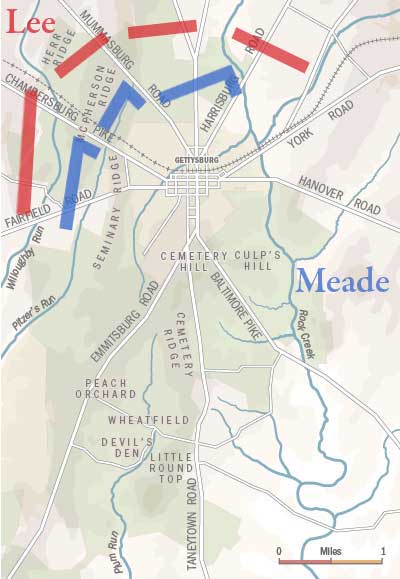
July 1, 1863. (Map by James Hilston/Post-Gazette)
Maj. Gen. John Buford, who commands the Union cavalry, climbs into the cupola of the Lutheran seminary, which sets on a slight ridge west of town. Buford is a tough Kentuckian whose father owned slaves and who has relatives fighting for the Confederacy. Up in the cupola, he has a spectacular view of the surrounding Pennsylvania countryside. His dismounted men are shooting from behind fences and trees. They’re greatly outnumbered. The best they can do is delay the advancing rebels. Buford looks to the south for signs of reinforcements. Reynolds’ forces are on the move, but there’s no sign of them yet.
As he rushes to Gettysburg, Reynolds hears the sounds of battle and gallops ahead of his troops to meet with Buford at the seminary. Both generals scan the countryside and agree it is a good place to fight. Union forces command the high ground.
Reynolds then moves elements of the oncoming 1st Corps into the fray. Among them is the legendary Iron Brigade, known as one of the army’s most dogged fighting outfits. These tenacious soldiers from the Midwest march into battle with their band playing "Yankee Doodle Dandy."
All the commotion on the northwest side of town stirs a grizzled 69-year-old Gettysburg resident named John Burns. He’s a veteran of the War of 1812, and when he hears the Confederates are on their way, he dons a blue swallow-tail coat with brass buttons, grabs his flintlock and marches down Chambersburg Pike, towards the gunfire. There, he hooks up with some Wisconsin boys in the Iron Brigade.
Quickly, the fight intensifies. Reynolds hurries troops into position, calling out, "Forward men, forward, for God’s sake." Within moments a bullet strikes him in the neck, killing him instantly. Reynolds is considered one of the army’s most capable generals. In fact, he had met a month earlier with President Abraham Lincoln to discuss the possibility of Reynolds' taking command of the entire Army of the Potomac. Now, Reynolds is among the first casualties in an escalating fight.
As the two armies blast away at each other, losses become staggering. One regiment of the Iron Brigade loses 80 percent of its men killed, wounded or missing. The old veteran John Burns is wounded three times and hobbles back to town, where he’ll spend the rest of the battle hiding from Confederates. By the end of the day, the legendary Iron Brigade is all but destroyed.
More Confederate troops pour in from the north and hit the Union’s right flank. Federal reinforcements rush into the battle from the south and soon the fighting spreads throughout the surrounding farmland. West and north of town, 19,000 Union troops and 24,000 Confederates are engaged in a bloody, pitched battle.
For Tillie Pierce, a 15-year-old Gettysburg girl, the morning of July 1 initially brings excitement. After breakfast, she hears Union troops are passing through town, so she rushes outside, to one of Gettysburg’s main streets. There, she joins others in singing patriotic songs as cavalry and then infantry and wagons move past. Between 9 and 10 o’clock, however, she hears the crack of musket fire on Seminary Ridge. At first, it is faint and distant, but the sound soon grows louder and louder. Then, she hears the booming of cannon. It, too, grows louder and more frequent. Finally, it becomes incessant. "This was my first terrible experience," she will later recall.
Tillie’s memories of the battle will be published years later — after she marries and becomes Tillie Pierce Alleman — in a book titled "At Gettysburg, or What a Girl Saw and Heard of the Battle."
Increasingly, Gettysburg residents are becoming alarmed. Tillie’s neighbor, a woman named Mrs. Schriver, determines that staying in town is too dangerous for her two children. Her parents live 3 miles south of Gettysburg, near a small, rocky hill called Little Round Top. Mrs Schriver decides she and her children will journey there. She asks if Tillie can join them. As smoke from the growing battle rises above Seminary Ridge to the west, Tillie’s parents agree. Before leaving, Tillie hides her best clothes in the basement of her home. Just in case.
The journey begins at 1 o’clock. At Evergreen Cemetery, Union troops are placing cannon. You’d better hurry, soldiers tell Tillie. Stay here and you’ll get shot.
"As I look toward the Seminary Ridge, I could see and hear the confusion of the battle," Tillie recalls. "Troops moving hither and thither; the smoke of the conflict rising from the fields; shells bursting in the air … . These things, beheld for the first time, filled my soul with the greatest apprehensions."

Tillie Pierce
Matilda J. ''Tillie'' Pierce was born in Gettysburg in 1848. Her father, James — a butcher, according to the 1860 federal census — and mother, Margaret, had four children, of which Tillie was the youngest. Tillie was 15 years old and attending a finishing school near her home in late June of 1863 when a portion of the rebel army came to her town. She wrote, ''What a horrible sight! There they were, human beings! clad almost in rags, covered with dust, riding wildly, pell-mell down the hill toward our home!'' (Photo from "At Gettysburg, or What a Girl Saw and Heard of the Battle")
At Taneytown Road, Tillie and the Shrivers are overtaken by an ambulance carrying a dead soldier. That’s the body of Reynolds, Tillie is told.
They stop at a small white farmhouse that will soon become Meade’s headquarters. A soldier there urges the travelers to move on, that it’s too dangerous here. So they’re put into a wagon with no springs and finish their journey jolting along on rugged, rutted roads.
Tillie’s departure is timely. Around 4 p.m., the Union’s right flank crumbles under the rebel attack. Federal forces begin a sometimes chaotic retreat through downtown Gettysburg. Shells burst overhead and bullets whistle through the air, striking homes and business. Streets are clogged with fleeing troops, ambulances, supply wagons and wounded horses. Injured soldiers stagger along, dripping blood.
One resident later writes that the crowd of soldiers in front of her house was so thick she could cross the street by walking on their heads. Seeking shelter, citizens dive into basements and peer through windows. Some federal troops get lost in what to them are unfamiliar streets, others hide in backyard sheds or are quickly taken in by residents and hidden. Still others organize a fighting retreat. In a few cases, soldiers engage in hand-to-hand combat.
By this time, Tillie is a safe distance from the danger in town. She and the Schrivers have arrived at the home of Mrs. Schriver’s father, Jacob Weikert. Almost immediately, Tillie notices Union artillery rushing past, soldiers lashing horses and shouting in a mad dash to the battle.
"Suddenly we behold an explosion," she writes. "It is that of a caisson. We see a man thrown high in the air and come down in a wheat field close by. He is picked up and carried into the house. As they carry him by, I can see his eyes are blown out and his whole person seems to be one black mass. The first words I hear him say is [sic]: "Oh, dear, I forgot to read my Bible today. What will my poor wife and children say?"
The soldier is carried into the Weikert home, placed on a bed and wrapped in cotton. He joins hundreds of other wounded men throughout the countryside whose groans and pleas now echo through houses and barns that have been converted to makeshift hospitals.
Wanting to be helpful, Tillie carries buckets of spring water to thirsty troops passing by. When the spring is emptied, she pumps water from a well near the house. By late afternoon, wounded soldiers are arriving in greater numbers. They come limping or crawling. Some are carried. They fill a barn on the Weikert property. Tillie is lured there by teenage curiosity.
"Nothing before in my experience had ever paralleled the site we then and there beheld," Tillie recalls. "There were the groaning and crying, the struggling and dying, crowded side by side, while attendants sought to aid and relieve them as best they could. We were so overcome by the sad and awful spectacle that we hastened back to the house, weeping bitterly."
As darkness falls over the town and fields of battle, Tillie’s father James Pierce emerges from the cellar of his Gettysburg home, where he and his family had sought shelter during the fight, and climbs to the attic. The Pierce family is harboring five Union soldiers, all of whom are sick or wounded. In the quiet moments of the night, James Pierce can clearly hear Union troops chopping, picking and shoveling as they build up breastworks on the hills and ridges south of town.
Lee, assessing the situation from Confederate headquarters on a hill west of downtown, must certainly know what those Union troops are up to. He is no doubt happy with the outcome of the battle — so far. He knows, however, that with federal forces occupying high ground, the fight is far from over.
Click and drag to explore the image.
i
At Little Round Top, visitors climb atop the battlefield’s largest monument for a panoramic view of the fields and hills where much of the bloodiest fighting of the war occurred on July 2. The monument honors the 12th and 44th New York Volunteer Infantry Regiments. (Panoramic by Steve Mellon/Post-Gazette)
Day of blunders and heroics
Thursday, July 2: News of the previous day’s events soon reaches Nevin and the Pennsylvania volunteers, marching through Manchester, Md., more than 20 miles from Gettysburg. For some soldiers, it’s a sad reminder of the defeat at Chancellorsville two months earlier. "General Reynolds killed, his Corps repulsed," Nevin writes. "Defeat again? We’ll not believe it." The volunteers hit the road and march through the night to reach the battlefield. "I became very sleepy," Nevin writes. "Nearly fell from my horse at times."
Also hurrying to the battle are Hays and the weary members of the 2nd Corps. Nearing Gettysburg on July 1, they hear the boom and crack of a raging battle. The troops stop 8 miles outside of town, and are on the march again at daybreak.
By now, the Union army is formed in a long line along on a series of ridges and hills south of Gettysburg. The defensive formation looks famously like a fish hook and extends 3 miles, curling from the massive wooded height called Culp’s Hill to Cemetery Hill, then running along a low rise called Cemetery Ridge to the rocky heights of Little Round Top.
At 7:30 a.m. on July 2, Hays and his men take up a position partially protected by a low stone wall just west of Cemetery Hill. This places them in the center right of the Union line. Confederate forces are stretched along a tree-lined rise called Seminary Ridge, less than a mile to the west. Separating the armies are undulating fields and farms and a road — Emmitsburg Road, which runs north into Gettysburg, near the Union line.
Almost immediately, Hays focuses his attention on a two-story barn about halfway between the Union and Confederate lines. The barn and a nearby house, part of a 60-acre farm owned by William and Addie Bliss, is now filled with Confederate sharpshooters tormenting the Union line. Hays orders some of his men to take the barn and clear out the rebels. After a pitched battle, Hays’ troops are driven back in disarray.
Hays then astonishes his men by mounting his favorite horse, "Dan," and galloping forward, into the fray. He’s accompanied by an aide whom Hays describes as a "reckless, devil-may-care Irishman" named Carroll. The two are within enemy range and, as they rally the federal troops and re-establish the line of attack, offer prime targets for Confederate sharpshooters.
"Our line held their breaths in suspense," Hays later writes to his father-in-law, "and I have since been told by several generals that they expected to see me blown up each minute. The enemy appeared to have been surprised, for not a gun of theirs opened up until my mission had been fulfilled and I had nearly reached our lines, when all the rebel batteries opened upon me and showered shot and shell."
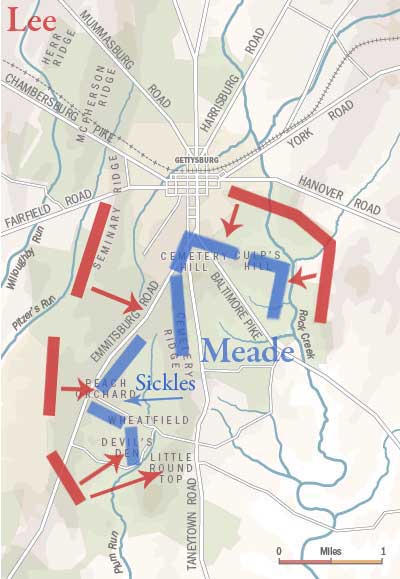
July 2, 1863. (Map by James Hilston/Post-Gazette)
Lee, surveying the Union line a mile or so away, no doubt hears the battle for the Bliss Barn. The federals, he realizes, command a very strong defensive position. Still, Lee has confidence in his men. Morale is high. His troops had routed the enemy the day before. Lee considers his options, confers with his generals, then decides to hit the Union army on its flanks — at Culp’s Hill and at Little Round Top. If Lee’s plan works, both sides of the Union line will collapse, the Army of the Potomac possibly destroyed. A dazzling victory on this day could force the north to sue for peace. Perhaps Lee can bring the devastating, 2-year-old war to an end.
Tillie Pierce begins July 2 by resuming her duty of carrying water to Union troops as they pass the Weikert home. She’s worried about her family, now stuck in a town occupied by the enemy. Are her parents safe? A number of rough boxes have been placed along the road just outside the Weikert’s garden fence. Tillie is chilled by the site of so many coffins.
Huddled in their Gettysburg home, her parents are unharmed but not out of danger. Confederate sharpshooters have taken up residence in the attic of a house next door and are picking off Union troops on Cemetery Hill. Blue-clad sharpshooters fire back. The Pierce home is struck by a number of stray bullets. Tillie will later count at least 17 bullet holes in the upper balcony.
Lee’s assault on the federal flanks gets off to a slow start. Confederate troops assigned to attack the Union’s left are led by Lt. Gen. James Longstreet. To avoid detection by the enemy, Longstreet’s troops take a long detour. Several hours pass before they are properly positioned. Finally, by 4 p.m., rebel forces are ready, but their assault is complicated by the actions of one colorful and controversial Union commander: Maj. Gen. Dan Sickles has made what many historians will consider a colossal mistake. He has moved his troops — the 3rd Corps, with French Mary as its vivandiere — off Little Round Top to a much more vulnerable location half a mile forward, in an area marked most notably by a peach orchard.
Sickles is a politician whose career contains more scandal than a tawdry novel. He had been censured for bringing a known prostitute into the New York state Assembly chambers, and had shot and killed the son of Francis Scott Key after Sickles discovered that the man was having an affair with his young wife. Sickles tirelessly lobbied and promoted himself, and by January 1863 had gotten himself named as a major general.
His move forward on July 2 at Gettysburg stretches his line too thin, creating a salient that can be attacked from several directions. The move outrages Meade, but there’s little he can do about it at the time. An attack, he realizes, is imminent.
The assault is launched by Longstreet, and it is indeed devastating to Sickles’ exposed divisions. During the next few hours, some of the war’s most desperate fighting takes place on the Union left. Musket fire and artillery tear apart soldiers in places soon to become famous — the Peach Orchard, the Wheatfield and an eerie collection of oddly stacked, oversized boulders christened Devil’s Den.
One of the casualties is Sickles himself. A cannonball mangles the general’s leg. As he is carried from the field, Sickles grins and casually smokes a cigar in an effort to bolster his troops’ morale. Still, the entire left flank of the Union line is in danger of collapsing.
Federal commanders rush to plug the hole left by Sickles’ maneuver. Hays sends his "White Glove Brigade" — the so-called "Cowards of Harpers Ferry." The soldiers charge into battle shouting "Remember Harper’s Ferry." On this day, they’ll suffer 450 casualties, or about one-third of their ranks, and erase their dishonorable reputation.
i
William Frassanito's groundbreaking book, "Gettysburg: A Journey in Time," was used as a guide in finding the original locations of photographs made in the days after the battle. Click on the flags and then mouse over the images to see how the battlefield has changed. (1863 photos courtesy Library of Congress; 2013 photographs by Steve Mellon/Post-Gazette; map by James Hilston/Post-Gazette)
Federal troops arrive just in time to meet a rebel attack.
For two hours, Little Round Top is shrouded in smoke as Union forces fight off waves of assaults. Blood soaks the soil and gathers in glistening puddles on the hill’s rocks. Cannon fire is so loud that those in the Weikert house can’t hear themselves talk.
Nevin and the 93rd Pennsylvania Volunteers hurry to the scene. Nearing Little Round Top, they see evidence of the battle ahead — wounded men on foot hobbling to the rear. "Rumors of how the fight is going crowd upon each other every moment! Musketry increases very much on the left and appear to come nearer, clearer, deadlier than before." The Pennsylvanians arrive as Union forces under Maj. Gen. George Sykes are being driven back. The rebel assault is checked.
Bloodied Confederate forces regroup and prepare for yet another uphill attack.
This is when Col. Joshua Chamberlain and his men of the 20th Maine step forward and become legends whose story will be told countless times in histories, novels and films. Chamberlain and his men occupy the lonely, extreme end of the Union’s left flank and have orders to hold the position at all costs. Now, with another assault on the way, the 385 soldiers from Maine find themselves dangerously low on ammunition. It’s a desperate situation. Chamberlain, a college professor with no formal military education, orders his men to fix bayonets. Then, the 20th Maine charges downhill in a move that’s at once a frontal assault and a flanking maneuver. It’s an audacious move that stuns the advancing Confederates, exhausted after a day of marching and repeated uphill assaults. Some rebels surrender, some flee back down the rocky slope. Thanks largely to a group of lumberjacks and fishermen from Maine, Little Round Top remains in Union hands.
Dusk begins to fall over the battlefield. The fighting, however, isn’t finished for the day. Further north, at the "barb" of the Union’s fish hook defensive line, Confederate troops commanded by Lt. Gen. Richard Ewell launch an assault on heavily wooded Culp’s Hill.
Union defenders have prepared themselves well: They’ve built impressive breastworks. In the fading light, rebel attackers are all but invisible except when they fire their weapons. The extreme right flank of the Union line is held by a group of New Yorkers led by Col. David Ireland. They’re outflanked by two Virginia regiments, then fall back to a trench and stage a heroic defense. The 137th New York loses almost a third of its men. Confederates suffer terrible casualties and are beaten back.
Both sides await dawn.
And where is French Mary on July 2? Her story here gets a bit more interesting. Much of Mary’s 3rd Corps is shredded after Sickles commands his soldiers off of Little Round Top and into what proves to be a deadly forward position. French Mary later claims that her first husband — the German immigrant Bernard Tepe — dies on the battlefield. In fact, French Mary says he called out for her as he lay mortally wounded then succumbed as she held him in her arms. It’s a gripping, tragic and romantic tale troubled by one nagging fact: Records show Bernard Tepe was captured at Gettysburg, discharged in 1864, and eventually worked as a tailor in Philadelphia.
By nightfall, Union troops continue to hold the high ground, but at very high cost. Nevin and his men sleep clutching their rifles. Hays and his troops rest a bit further north on the Union line. The soldiers of the 3rd Corps, wrecked as a result of Sickles’ move forward, are judged unfit to fight further and are held in reserve.
Moans and cries of wounded and dying men in the fields behind the Union line haunt Nevin and the Pennsylvanians. Perhaps Hays and French Mary can hear sounds of agony, too. Before them all and illuminated in the eerie glow of a full moon, is a patch of ground where, within 24 hours, the future of the country will be determined. Nevin, Hays and thousands of others know that the coming day will be deadly for many.
"Terrible night," Nevin writes. "What sights, what sounds. What will the ‘morrow bring?"
Click and drag to explore the image.
i
Moonlight illuminates the stone wall at the Angle, where a few hundred Confederate soldiers breached the Union line on the afternoon of June 3. Rebel troops had begun their assault on Seminary Ridge and had crossed nearly a mile of open fields, thus exposing themselves to murderous fire. (Panoramic by Steve Mellon/Post-Gazette)
A desperate attack
Friday, July 3: As the sun rises on what promises to be an uncomfortably hot day, whiffs of smoke rise from depressions along the Union line. Soldiers brew coffee and nervously peer into the distance, looking for signs of the enemy. An attack, they realize, is imminent.
Gunfire has already erupted on the right, at Culp’s Hill. Rebels who had gained a toehold at the Union’s right flank the previous day now find themselves in a dangerous position. They had spent the night halfway up the slopes of the hill they had assaulted the day before. Now, federal troops are looking down on them. Before dawn, Union batteries begin blasting away at the rebel line. For more than an hour, Confederate troops hug the ground, seeking shelter behind rocks and in trenches while shells burst around them. Finally, the bombardment stops. Confederate troops rise and surge forward.
For more than five hours, both sides wage a bloody battle.
Hays, from his position near the center of the Union line, no doubt can hear the booming of artillery and the crack of musket fire a mile east of his position. He has an immediate concern of his own, however. Once again, Confederate sharpshooters have occupied the Bliss barn and house and are drawing beads on federal officers. Sometime between 7 and 7:30 a.m., Hays sends an order: "Take the house and barn and hold at all hazards." Two Union regiments move in and drive the rebels out. Confederates respond by blasting artillery into the structures. Finally, Hays gives the order to put an end to the daylong skirmish over a bunch of farm buildings. Burn the house, burn the barn, he says.
Black smoke from the flaming structures rises over the battlefield, which now falls eerily silent. At noon, heat and anticipation weigh on both Union and Confederate troops. Hays’ men wait behind the stone wall on the ridge. Some hold as many as four rifles. Hays has ordered the soldiers to round up all abandoned arms and have them cleaned, loaded and ready to use. The burly general knows a brutal battle is to come. He tells his officers to shoot any man who skulks or shows cowardice.
A mile or so west of Hays, beyond the undulating farmland, Confederate soldiers are massing behind tree-lined Seminary Ridge. Two days of hard fighting have left the rebels soldiers weary and hungry. Now, they’re lying in the heat, trying to stay cool and out of sight. Some relieve the tension by tossing sour apples at each other. No doubt a few peek out into the valley and see the smoking ruins on the Bliss farm and the Union troops in their well-fortified position on the ridge in the distance. The rebels know they’ll soon have to cross that valley and climb the gradual slope of the opposite ridge, and, in doing so, expose themselves to a murderous fire.
The job of leading the assault will go to an odd, dapper man with a curly chin-beard, droopy mustache and hair that dangles in perfumed ringlets at his neck. His name is Maj. Gen. George Pickett. For two days, his troops marched along dusty roads, following the sounds of battle to Gettysburg. They’ve missed the first two days of the fight. The jaunty, swashbuckling Pickett, with his polished boots and glinting spurs, is anxious to distinguish himself. He has never led his troops into battle. Soon, he will get that chance. Lee has given Pickett the distinction of leading an attack designed to break the Union line.
Shortly after 1 o’clock, two sharp, successive cracks from Confederate cannon near the Peach Orchard break the silence. This is the signal other rebel batteries have been waiting for. Within moments, 140 Southern cannon erupt, blasting away at the Union line in what is recognized as the largest artillery bombardment of the war. The thunderous fusillade creates the loudest sound ever generated on the continent. In fact, it’s heard in Pittsburgh with such clarity that some are convinced the city is under attack.
On Cemetery Ridge, Union troops dive for cover. Projectiles passing overhead hiss, then burst, filling the air with "murderous iron," one soldier recalls. Federal troops brave enough to raise their heads see the Confederate position blanketed in smoke, punctured continually with flashes of flame from discharging artillery.
To Union troops on the front lines, the smoke is a blessing. It blinds the Confederate gunners, many of whom fire their shells too high, sending projectiles over the ridge. Shells tear into federal supply wagons, reserve troops, ammunition trains, ambulances and stragglers who had assumed they were relatively safe.
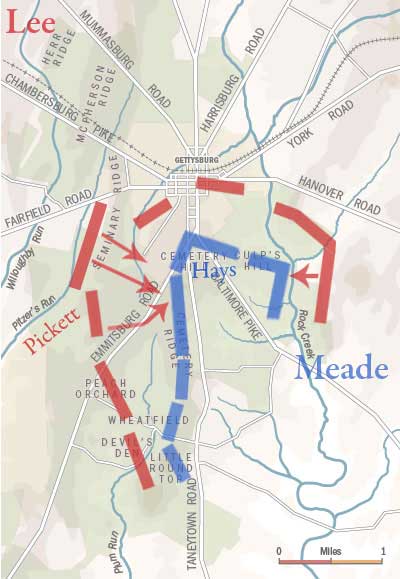
July 3, 1863. (Map by James Hilston/Post-Gazette)
At the small farmhouse Meade and his commanders are using as a headquarters, shells fall in stunning numbers, "as many as six a second," reports The New York Times. Even the battle-hardened Union command is amazed. One shell rips away the steps of the farmhouse, another crashes through the roof. Meade himself is narrowly missed by a shell ripping through the door. Outside, an ambulance driver tries desperately to control his horse, which gallops along on three legs, one having been shot off at the hock. Finally, Meade and his staff flee the house to seek safer ground, only to discover their horses — 16 in all — are dead, mangled and yet still fastened by their halters.
Nevin, with his Pennsylvania volunteers on Cemetery Ridge just north of Little Round Top, reports that one piece of Confederate artillery "got our range and annoyed us considerably. Gen. Bartlett [Brig. Gen. Joseph J. Bartlett] was within an inch of losing his head. He looked around and smiled at the little tree behind him which was cut (in two) by the shot."
Hays is closer to the Union center, where generals seem to be in competition to be the most cavalier. Hays rides up and down the line, telling his troops to "stand fast and fight like men" when the assault comes. Hancock, too, famously rides about on horseback, encouraging his men. And Brig. Gen. Alexander Webb leaves himself conspicuously exposed, calmly smoking a cigar.
Watching the barrage from Little Round Top is a 23-year-old soldier named Luther Calvin Furst. Two years earlier, Furst had walked from Cannonsburg to Pittsburgh to enlist in the Union army. Within a few months, he had been assigned to the signal corps. Since then, he had served in more than his share of battles, including those at Antietam, Fredericksburg, Chancellorsville.
Furst had arrived on the field of battle at 4 o’clock the day before, during the battle for Little Round Top. Once the hill was secure, Furst and his colleagues set up a signal station there, within rifle shot of the enemy.
Now, the position is the target of Confederate shells. Artillery fire kills a horse just a few yards away from Furst, and a fellow soldier standing nearby is struck with a piece of iron from an exploding shell.
At one point, Furst is ordered to deliver a dispatch to Meade’s headquarters. The task requires him to ride the entire length Union line. "The boys would yell out: ‘You better stop orderly, you will never get through,’ " Furst writes later that day, "But I was bound to try it, putting my horse on a breakneck pace, delivered my dispatch to General Meade, nearly killing my horse."
By day’s end, seven men on the Little Round Top signal station will be killed or wounded by sharpshooters in Devil’s Den, Furst writes.
For more than an hour, shells soar and burst over the Union line. Then, silence returns. Federal troops on the ridges and heights raise their heads and look across the valley. As the smoke slowly clears, more than 12,000 Confederate troops emerge from the trees on Seminary Ridge and march into the open field. Afternoon sunlight sparkles off of their weapons as they form in double and triple ranks, flags waving. The line of rebel soldiers stretches for a mile. For many watching on the Union line, it’s a sight of tremendous beauty and gallantry.
Hays, riding along his line, waves his sword and calls out exultantly, "Now boys, look out. You will see some fun."
Small clouds of dust rise from the field as the Confederate army moves forward. For three minutes they march only to the rustling and clinking sound of their own movement through farm fields. Then they fall within range of Union artillery and the roar of cannon fills the valley. Massed as the rebels are, shells tear through their ranks. As the dead and wounded fall, the soldiers re-form their lines and continue on. Rebels pass the smoldering remnants of the house and barn burned by Hays’ men earlier that day. Union artillery units on Little Round Top shoot down the length of the Confederate line, taking out as many as 10 soldiers with one shell blast.
At Emmitsburg Road, the rebels must cross a fence line, then re-form before proceeding. Here, they are within range of Union rifles. Hays’ troops, lined up as many as four deep behind a stone wall, deliver a deadly barrage. Once a soldier fires his weapon, he falls back to reload as another soldier takes his place at the front.
Confederates receive a demoralizing, devastating attack on both flanks as they draw nearer to the Union line.
Still, the assault continues. As the rebels make their way up the slope to Cemetery Ridge, federal cannon open up with canister shot, sending shotgun-like blasts of lead spheres the size of golf balls into the advancing foe. Clumps of men evaporate in clouds of dust and smoke. Body fragments, weapons and knapsacks fly through the air. The Confederate line staggers. Indeed, many observers wonder how any group of men can withstand such withering fire. Yet the rebels gather themselves to make a desperate push up the slope.
Hays is able to swing some of his troops forward to strike the attacking enemy on its flank. Rebels there fall in heaps. Survivors throw themselves flat on the nearby Emmitsburg Road to escape the fire, many waving hats and handkerchiefs to indicate surrender.
By now, so many rebel officers have been killed or wounded that Confederate forces spearheading the attack are largely leaderless. A few hundred rebels reach the stone wall as it turns at an angle, near a small clump of trees at the center of the Union line. Brig. Gen. Lewis Armistead leads the Confederate charge, holding his saber high with his black hat balanced on its tip. "Follow me," Armistead calls out as he crosses over the wall. Several hundred rebel soldiers follow. A 200-foot section of the federal line has been breached.
It is here, in a small piece of real estate just a few hundred feet wide, that the outcome of the battle and the war, as well as the future of the country, will be decided. It all happens within a few minutes.
Much of the fighting is now hand-to-hand, the air filled with smoke and screams and curses, the moans of the wounded and dying, the crack of rifle and pistol fire, and whizzing bullets as soldiers fire at point-blank range.
Fire pours in from Hays’ men on the right and from troops commanded by Brig. Gen. George Stannard on the left. For their success in breaching the line, the rebels suffer terribly. One Mississippi company loses 100 percent of its members either killed or wounded. The rebels, unsupported and now outnumbered, cannot hold their ground. As the attack melts away, large numbers of Confederate troops surrender. Others try to extricate themselves from their now disastrous position and begin making their way back to the safety of the Confederate line on Seminary Ridge. It is a long, dangerous and humiliating trek. They stumble over their own dead and continue to suffer from union fire. At Seminary Ridge is Lee, the Confederate commander who had seemed so infallible. He rides up and down the line, repeating, "It’s all my fault, it’s all my fault."
Back on Cemetery Ridge, Hays is exultant. His troops have played a key role in driving off a rebel assault that could have changed the course of the war — and the nation. In fact, Hays is so caught up in the moment that he grabs a young lieutenant and plants a kiss on his face. He then calls for someone to bring him some captured enemy flags, dozens of which had been snatched up during the battle. Hays has a plan.
Astride a horse with blood-splattered flanks, he rides erect and smiling along his line of troops while dragging the rebel colors behind him in the dust. Joining him are two of his officers. Hays continues his ride into the open field, where he presents a juicy target for Confederate sharpshooters. One Union soldier says of Hays, "I reckon him the grandest view of my life. I bar not Niagara (Falls)." Remarkably, Hays is not struck down by a rebel bullet.
This may be the result of luck, or the intervention of an old friend. Years after the battle, one of Hays’ lieutenants is told by a former Confederate officer that, while Hays was dragging the rebel flag, an order was given to shoot him down. A superior officer immediately countermanded the order, saying, "No, don’t shoot him. That’s Sandy Hays."
That superior office, the lieutenant believes, was Longstreet, Years earlier, Hays and Longstreet had served together in Mexico.
Luck has been with Hays throughout this shockingly violent day. During the battle, two horses were shot from beneath him — his beloved "Dan" was killed by a cannonball through the heart and a second horse, named "Leet," took three shots to the chest. Hays had lost all but six of his 20 orderlies. All around him lie the dead and dying. "The battle cannot be described except as the most terrible fought between men," he later writes his wife.

Tillie Pierce and Mrs. Schriver were warned early on July 3 that staying in the Weikert house could be dangerous. Soldiers had placed cannon on two sides of the house in anticipation of a rebel assault. It’s possible, the soldiers say, that heavy fighting could take place on the property. So once again, Tillie and the Schrivers flee, this time to a farm house farther east of town and a safer distance from the fight. The house, Tillie learns, is filled with others forced to leave their homes, and together they listen to the terrible sounds of the desperate Confederate attack.
As the afternoon progresses, the roar of battle diminishes and then, finally, there is silence. In the cool of the evening, Tillie and the Schrivers journey back to the Weikert home. The countryside, Tillie notices, seems "filled with desolation." Fences have been torn apart. Knapsacks and blankets are scattered about.
At the Weikert house, "I fairly shrank back aghast at the awful sight presented. The approaches were crowded with the wounded, dying and dead. The air was filled with moanings and groanings. As we passed on toward the house, we were compelled to pick up our steps in order that we might not tread on the prostrate bodies."
Soldiers are lifted onto amputating benches, where surgeons saw off limbs and probe into wounds to remove bullets and shrapnel. Tillie is growing accustomed to such sights.
"Some of the soldiers fairly begged to be taken next, so great was their suffering, and so anxious were they to obtain relief," she writes.
Surgeons use chloroform to anesthetize the wounded soldiers, but the effort sometimes fails, "for I saw the wounded throwing themselves wildly about, and shrieking with pain while the operation was going on."
In the yard, Tillie notices a pile of limbs that rises higher than a nearby fence.
The rebels have been whipped, she hears the soldiers say, but at an awful price.

Toward evening, news of the great Union victory in Gettysburg filters into town. The city that, just a few days earlier, had feared its factories would be destroyed by an unstoppable enemy, can rest more easily now that the Confederates are limping back home. Celebration in the city begins anew. From the fortifications, rockets are fired into the darkening sky. Downtown, mischievous boys throw fireworks under horses’ feet, causing a few runaways. No one is hurt, though one carriage is smashed when its frightened horse bolts away, out of control. The "usual quantity of drunken men" join in the festivities, reports the Post. "But we saw little fighting."
We can imagine the happiness and relief felt by little Maggie Wade Campbell, across the river from the boisterous revelry in Pittsburgh. If the adults once so fearful are now celebrating, certainly her home is now safe from rebel invaders who would demand the family’s silver. And the black servants she knows as friends are no longer in danger of being captured and sent south to be slaves.
Maggie will know other dangers this summer — in fact, Confederate Gen. John Hunt Morgan is just beginning his short-lived raid into the North, sweeping into southern Indiana and then Ohio with a force of more than 2,000 troops. On July 26, Morgan and what remains of his force will be stopped in Salineville, Ohio, 60 miles west of Pittsburgh, offering yet further relief to Maggie and all of Western Pennsylvania. But on this night, at least, Maggie can be calmed from her night terrors, and the rebel soldiers she dreamed were under her bed, preparing to drive spears through her body.
While Pittsburgh celebrates, wounded Confederate soldiers are making an agonizing trip south in a wagon train that stretches 17 miles. The train is a nightmare of mutilation: men with shattered legs, shredded arms, torn and punctured mid-sections and crushed bones. "Their ragged, bloody, and dirty clothes are clotted and hardened with blood," writes Confederate Gen. John Imboden, who is escorting the convoy.
The springless wagons jolt along over rocky, bumpy roads. Shortly after noon on July 4, a violent storm erupts, sending sheets of rain onto the wounded, who lie on hard, wooden boards. As he rides up and down the train, Imboden can hear men inside the wagons crying out, "My God, will no one have mercy and kill me?"
And, "Oh, God, why can't I die?"
In the days after the battle, French Mary remains in Gettysburg, serving as a nurse in a field hospital on Taneytown Road, near Little Round Top. On at least one occasion, she returns to the battlefield, where she is photographed among rocks and boulders and a fortification made of dirt, stone and wood. She wears her Zouave uniform. A bonnet sits upon her head as she stares pensively into the distance.
With her husband, Bernard Tepe, one of the battle’s casualties — she reports him killed in battle, though in truth he has been captured by the rebels — French Mary now fancies a soldier named Richard Leonard. Leonard, like Bernard Tepe, is a German immigrant. Once again French Mary is moved to marry. The ceremony, she later claims, takes place on the Gettysburg battlefield, though no record of that ceremony exists. Bernard Tepe, the husband who had died so dramatically in her arms, winds up back in Philadelphia, once again working as a tailor.
Both French Mary and her new husband will survive the war and eventually make their way west, to a shanty on Lafferty’s Hill in Baldwin Township, near Pittsburgh. There, with the bullet from Fredericksburg still lodged in her foot, French Mary will support herself by selling toys.
On Tuesday, July 7, Tillie Pierce, Mrs. Schriver and her two children journey back to their homes in Gettysburg. Roads are thick with mud and impassable, so the four walk across fields. Tillie is appalled by what she sees. "While passing along, the stench arising from the fields of carnage was most sickening. Dead horses, swollen to almost twice their natural size, lay in all directions. Stains of blood frequently met our gaze, and all kinds of army accoutrements covered the ground. Fences disappeared, some buildings were gone, others ruined. The whole landscape had been changed, and I felt as though we were in a strange and blighted land."
Rotting horse carcasses have become a problem. Approximately 5,000 dead animals litter the fields around Gettysburg. Most are horses, difficult to move and bury. So the bloated bodies are dumped in huge piles, doused with kerosene and set afire. Some massive mounds of horseflesh will burn for two weeks.
Reminders of death fill the air around Gettysburg. Residents carry bottles of pinion oil and peppermint to dull the stench, and fat green bottle flies gather so thickly on fence rails that the rails themselves seemed to surge with life.
In Pittsburgh, less than 200 miles away, the only stench residents endure is that which they’ve learned to live with — the sharp, thick smell of industry. Life in the city is returning to normal. Businesses in Downtown unlock their doors, smoke once again pours from the chimneys of iron works, foundries, tanneries and tin shops. Lively crowds once again gather in the streets. Mayor Benair C. Sawyer calls for the city’s residents to commemorate the Union victory by uniting in a "grand illumination and display of fireworks." But Stein Brothers clothing store at Fourth and Wood streets does not wait for an official invitation. As night falls on July 7, nearly 2,000 candles illuminate the building. Flags fly from all windows, and fireworks are tossed from the roof. A large, happy crowd gathers outside the store and remains much of the night, basking in the glow.


